# Teaching Your Furry Friend to Stroll with Ease: Mastering the Art of Loose Leash Walking
As a proud puppy parent, you might have experienced the not-so-leisurely walks where your furry bundle of energy drags you down the street. Teaching your pup to walk on a loose leash is not just about having a more enjoyable stroll; it’s an essential skill for their safety, your peace of mind, and a stronger bond between you both. With patience, consistency, and the right techniques, you can transform leash pulling into a harmonious walk in the park.
## The Importance of Loose Leash Walking
Loose leash walking is a fundamental skill that ensures your puppy learns to walk calmly by your side, paying attention to you while avoiding pulling and lunging. This skill is crucial for several reasons. Firstly, it prevents accidents and injuries that can occur when your dog pulls on the leash, keeping both you and your pup safe. Additionally, it allows you to have better control during walks, making it easier to manage your dog’s interactions with other people and pets. Lastly, it strengthens the bond between you and your furry companion, as they learn to trust and follow your lead.
## Getting Started: The Basics
Begin teaching your puppy loose leash walking as soon as possible, ideally when they are around 8 to 10 weeks old. Puppies are like sponges at this age, eager to learn and absorb new skills. Here’s a step-by-step guide to get you started:
1. **Equipment Choice:** Use a fixed-length, lightweight leash and a flat collar or a harness for training. Avoid retractable leashes, as they can encourage pulling. A harness is recommended for better control and to prevent choking.
2. **Setting the Tone:** Start in a quiet, low-distraction environment, like your backyard or a quiet park. This helps your puppy focus solely on you.
3. **Introducing the Leash:** Let your puppy get used to the leash by attaching it to their collar or harness and allowing them to drag it around. Reward them for any positive interaction with the leash, like sniffing or walking near it without pulling.
4. **Reward-Based Training:** Positive reinforcement is key. Use treats, praise, or play as rewards for good behavior. Keep treats small, soft, and varied to maintain your pup’s interest.
## Teaching the ‘Heel’ Command
The ‘heel’ command is the cornerstone of loose leash walking. Here’s how to teach it:
1. **Start in a Calm State:** Begin when your puppy is calm, not when they’re already pulling.
2. **Lure and Reward:** Hold a treat at your puppy’s nose, then raise it to your chest level, luring them into the ‘heel’ position. As they follow the treat, take a few steps, and say “Heel.” When they are by your side, reward and praise them.
3. **Repeat and Practice:** Practice in short sessions, gradually increasing the number of steps and duration. Always reward when they stay in the ‘heel’ position.
4. **Add Verbal Cue:** Once they understand the action, introduce the verbal cue “Heel” before luring. Eventually, your puppy will respond to the verbal cue alone.
## Perfecting the Walk
Consistency is key to mastering loose leash walking. Here are some tips to refine your puppy’s skills:
– **Practice Regularly:** Make leash walking a daily routine, even if it’s just for a short distance.
– **Change Scenery:** Gradually introduce new environments and distractions. Reward for calm behavior in these situations.
– **Keep it Fun:** Vary your walking routes and use different types of treats to keep training sessions exciting.
– **Be Patient:** Puppies have short attention spans. End sessions before they lose interest, and always on a positive note.
– **Use Treats Strategically:** Gradually reduce treats, but never stop rewarding good behavior with praise and affection.
## Troubleshooting Common Issues
### Pulling:
– Stop and change direction when your puppy pulls, rewarding when they return to your side.
– Use a front-clip harness to steer them back to your side.
– Engage their attention with treats or a squeaky toy.
### Lunging at Distractions:
– Increase distance from the distraction and reward calm behavior.
– Teach a ‘Watch Me’ command to redirect their focus to you.
– Practice in less stimulating environments, gradually building up.
Teaching your puppy to walk on a loose leash is a journey, but with persistence and positive reinforcement, you’ll both master this essential skill. Remember, the more you practice, the more natural and enjoyable your walks will become. Happy training and even happier strolling!

